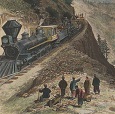As COVID-19 deaths spiked in 2020, Suzanne Firstenberg’s public art installation "In America: How could this happen…"
History Explorer Results (89)
Related Books (11)

Grade Range:
K-12
Resource Type(s):
Artifacts, Primary Sources
Date Posted:
9/3/2008
Cesar Chavez inspired a nation to seek justice for the poorest of America's laborers. A migrant worker since childhood, Cesar Chavez pledged his life to improving the lives of his fellow workers, rather than escape the stark conditions of farm labor. Inspired by the tireless conviction of Mahatma

Grade Range:
K-12
Resource Type(s):
Artifacts, Primary Sources
Date Posted:
9/17/2009
The Spaniards who invaded Mexico brought to North America a well-developed equestrian tradition. Over the centuries, horses, saddles, and other riding paraphernalia were altered by the landscape and the lifestyles of both Spanish and indigenous riders. Accompanied by mariachi music, la charrería

Grade Range:
K-12
Resource Type(s):
Artifacts, Primary Sources
Date Posted:
9/3/2020
A U.S. Border Patrol official reviews a bracero's documents while others wait in line to be processed at the Hidalgo Processing Center, Texas.

Grade Range:
6-12
Resource Type(s):
Artifacts, Primary Sources
Date Posted:
3/5/2009
This Thai passport was seized in the well-publicized 1995 El Monte, Calif., sweatshop raid. The passport is part of a larger Smithsonian collection of artifacts documenting apparel industry sweatshops, focusing on the El Monte operation (72 workers were discovered working as slaves). With a legit

Grade Range:
K-12
Resource Type(s):
Artifacts, Primary Sources
Date Posted:
9/3/2008
Cesar Estrada Chavez, the founder of the United Farm Workers of America, is one of the most recognized Latino civil rights leaders in the United States. A Mexican American born in Yuma, Arizona, his family lost their small farm in the Great Depression (1930s). Like many Americans, they joine
Grade Range:
9-12
Resource Type(s):
Reference Materials, Primary Sources
Date Posted:
7/7/2008
Students can read the stories of immigrants from Mexico, Cuba, and other Latin American countries, and view objects related to the journey to America. Students can also learn about the experiences of workers in the in the mid-twentieth century Bracero guest worker program. This reference page is

Grade Range:
K-12
Resource Type(s):
Artifacts, Primary Sources
Date Posted:
3/5/2009
By the 1700s, samplers depicting alphabets and numerals were worked by young women to learn the basic needlework skills needed to operate the family household. The earliest dated sampler in the museum's collection was made in 1735 by Lydia Dickman of Boston, Massachusetts.

Grade Range:
5-12
Resource Type(s):
Artifacts, Primary Sources
Date Posted:
9/2/2020
Demand for inexpensive, mass-produced women’s clothing spurred the rise of early garment factories. The ILGWU was formed in 1900 by bringing together several smaller local unions to fight to end sweatshop production, higher wages, and improve working conditions in the cities where the garment fact

Grade Range:
K-12
Resource Type(s):
Reviewed Websites
Date Posted:
8/25/2014
Between 1865 and 1869, thousands of Chinese migrants toiled at a grueling pace and in perilous working conditions to help construct America’s First Transcontinental Railroad. The Chinese Railroad Workers in North America Project seeks to give a voice to the Chinese migrants whose labor on

Grade Range:
K-12
Resource Type(s):
Artifacts, Primary Sources
Date Posted:
9/3/2008
The short-handled hoe brings back memories of back-breaking labor for generations of Mexican and Mexican American migrant workers who sustained California's booming agricultural economy.



















